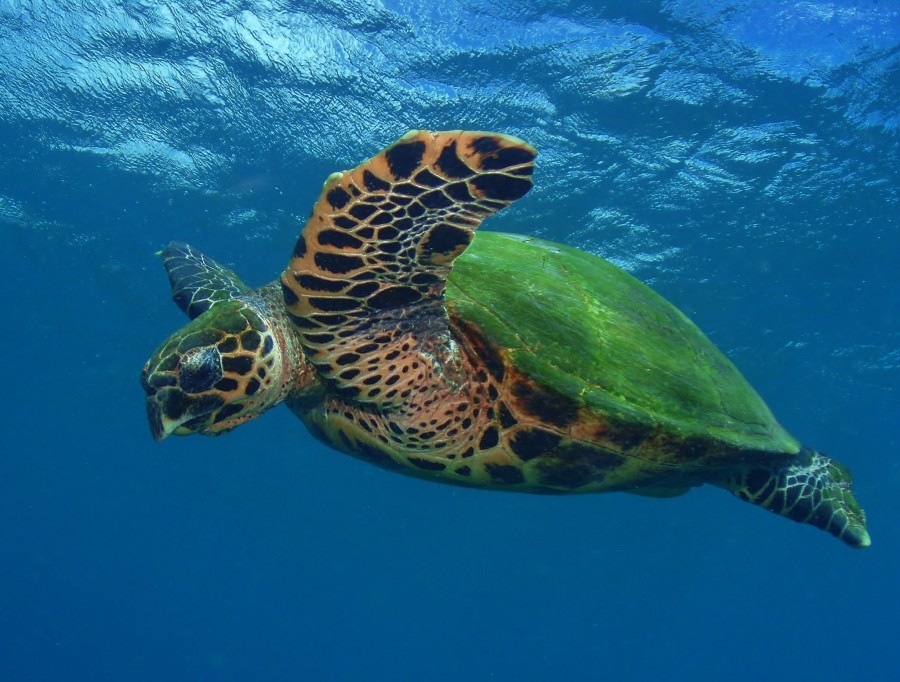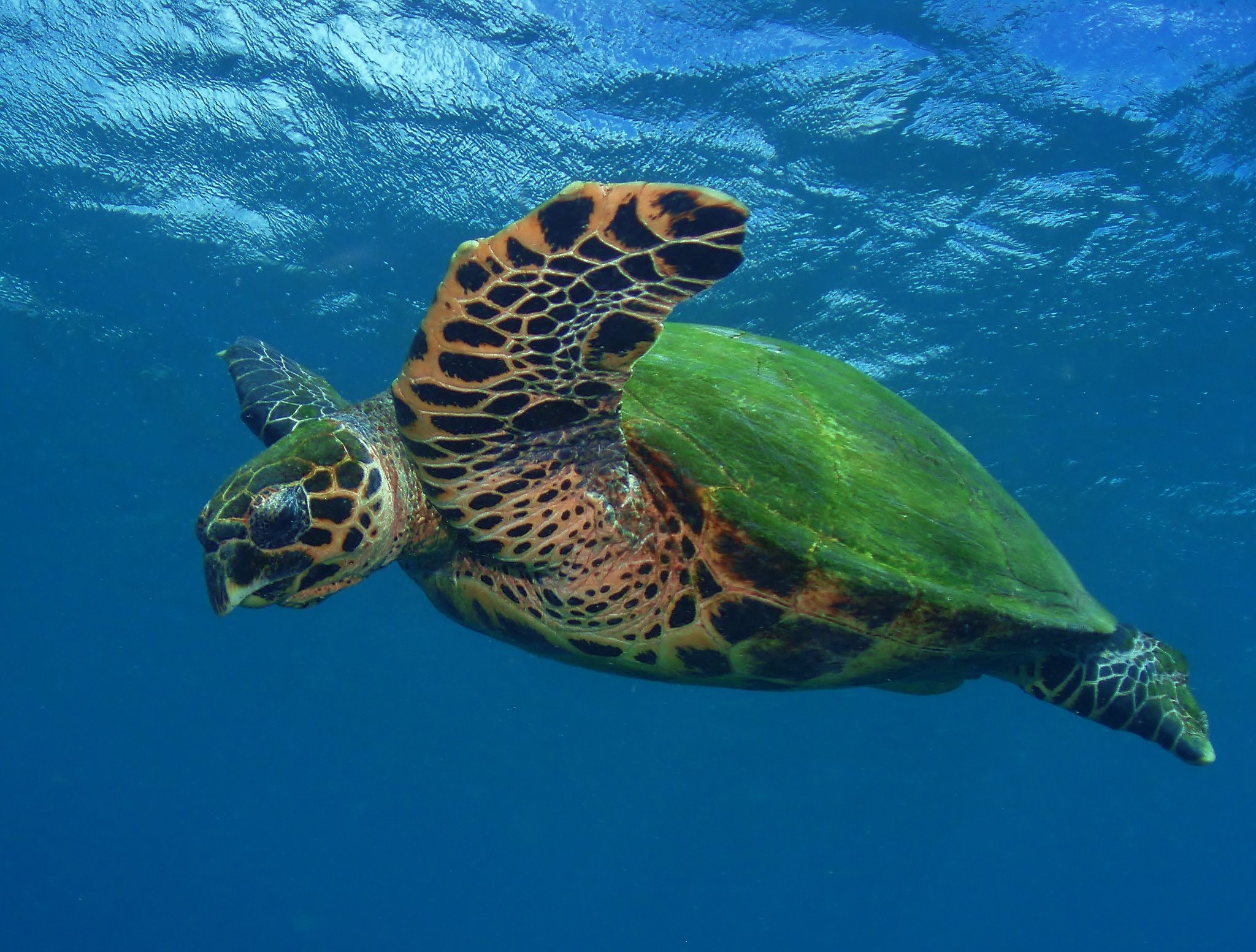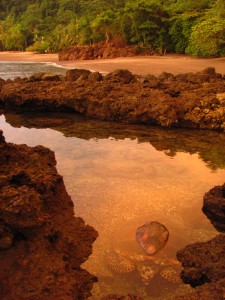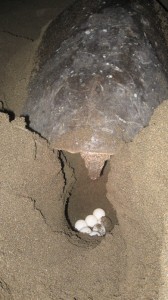Hawksbill Turtles
Current Status
The hawksbill sea turtle (Eretmochelys imbricata) is listed as a critically endangered species by the IUCN. It is also listed as endangered throughout its
range by the Endangered Species Act of 1973. An exhaustive review of the worldwide conservation status concluded that the global hawksbill population is known to be declining. Severe declines were noted across the globe.
It is sobering to consider that current nesting levels may be far lower than previously estimated. Despite protective legislation, international trade in
hawksbill shells and subsistence use of meat and eggs continue unabated in many countries and pose a significant threat to the survival of the species in the region. The most recent status review of the hawksbill in Costa Rica recognized that numerous threats still exist despite decades of protection.
Description
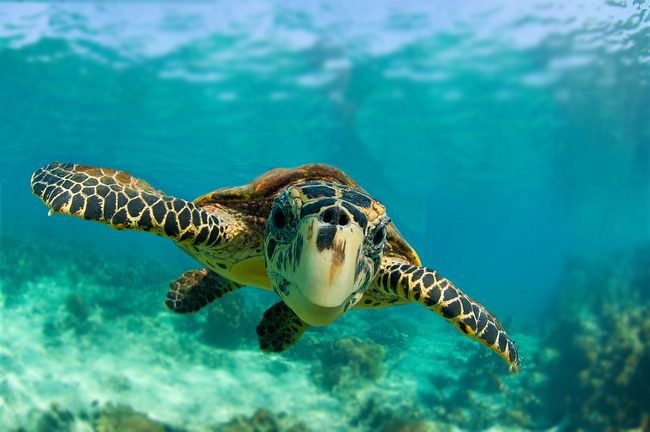 The hawksbill’s appearance is similar to that of other marine turtles. It has a generally flattened body shape, a protective carapace, and flipper-like arms, adapted for swimming in the open ocean. E. imbricata is easily distinguished from other sea turtles by its sharp, curving beak with prominent tomium, and the saw-like appearance of its shell margins. Hawksbill shells slightly change colors, depending on water temperature. While this turtle lives part of its life in the open ocean, it spends more time in shallow lagoons and coral reefs.
The hawksbill’s appearance is similar to that of other marine turtles. It has a generally flattened body shape, a protective carapace, and flipper-like arms, adapted for swimming in the open ocean. E. imbricata is easily distinguished from other sea turtles by its sharp, curving beak with prominent tomium, and the saw-like appearance of its shell margins. Hawksbill shells slightly change colors, depending on water temperature. While this turtle lives part of its life in the open ocean, it spends more time in shallow lagoons and coral reefs.
The following combination of characteristics distinguishes the hawksbill from other marine turtles:
- two pairs of prefrontal scales
- thick, posteriorly overlapping scutes on the carapace
- four pairs of costal scutes (the anteriormost not in contact with the nuchal scute)
- two claws on each flipper
- a beak-like mouth, hence the name.
Additionally, on land the hawksbill has an alternating gait, unlike the leatherback and green sea turtles.
The carapace is heart-shaped in the youngest turtles and becomes more elongated as the turtle matures. The sides and rear portions of the carapace are sharply serrated in all but very old animals. The epidermal scutes that overlay the bones are the tortoiseshell so prized by commerce. Hawksbill shells are the primary source of tortoiseshell material used for decorative purposes.
Habitat
Hawksbills use different habitats at different stages of their life cycle. It is widely believed that posthatchling hawksbills are pelagic and take shelter in weedlines around convergence zones. Marine plants and floating debris such as styrofoam, tar balls, and plastic bits (all common components of weedlines) are consistently and sadly found in the stomachs of youngsters.
Hawksbills reenter coastal waters when they reach about 20-25 cm carapace length. Coral reefs are the resident foraging grounds for juveniles, subadults and adults. Hawksbills exist on the diet of sponges–commonly found on the solid substrate of reef systems. Ledges and caves of reef systems provide these turtles with shelter for resting during the day and night. Hawksbills can be found around rocky outcrops and high-energy shoals, which are optimum sites for sponge growth.
Hawksbills nest on low- and high-energy beaches in tropical oceans of the world, frequently sharing high energy beaches with green turtles. Hawksbills will nest on small pocket beaches and, because of their small body size and agility, can cross fringing reefs that limit access by other species.
Diet
Sponges are the principal diet of hawksbills once they enter shallow coastal waters and begin feeding on the bottom. While diet studies have focused on the Caribbean, there is evidence that eating sponges is a worldwide feeding habit. A high degree of feeding selectivity is indicated by the consumption of a limited number of sponge species. Sponge predation by hawksbills may influence reef succession and diversity by freeing up space on the reef for settlement by benthic organisms. The hawksbill’s highly specific diet and its dependence on filter-feeding, hard-bottom communities make it vulnerable to deteriorating conditions on coral reefs around the world.
Reproduction
The nesting season of the hawksbill is longer than that of other sea turtles. Nesting occurs between May and December and courtship and mating begin
somewhat earlier. Nesting in the Caribbean and Pacific is principally nocturnal, although rare daytime nesting does occur.
Nesting behaviour follows a general sequence of that of other species of sea turtles: emergence from the sea, site selection, site clearing and pit construction, egg chamber construction, egg laying, filling in the egg chamber, disguising the nest site, and returning to sea. The entire process takes about 1 to 3 hours.
Hawksbills nest on average 4.5 times a season and intervals of about 14 days. Hawksbills have a strong site fidelity to specific nesting beach areas and are capable of returning to the same place season after season. Clutch size is correlated to female carapace length. In pacific Costa Rica, clutch size is about 120 eggs. Eggs are about 40 mm in diameter and take about 60 days to hatch. Sex determination is likely temperature-dependent as in other sea turtles and many reptiles, but data is limited.
Threats
Hawksbills face most of the same dangers that all marine turtles face. Sadly, they are also singled out for their own special threat: humans find their shells highly attractive. The full extent of the threat is not known, but experts believe that the killing of hawksbills for shell material is a major problem.
Japan is the major consumer of turtle shell, but there is significant trade within the Caribbean as well. Although Japan has signed the Convention on International Trade in Endangered Species of Wild Fauna and Flora (CITES), it exempted itself from the ban on hawksbills (among others). Likewise, Cuba exempted itself, giving rise to a convenient trade opportunity. There is also a significant impact and concern for humans poaching nests for egg consumption throughout central America.
The odds, unfortunately, are against the turtles. It is for this reason they need all the help they can get. Get involved and assist us in our conservation efforts by volunteering or making a donation.


